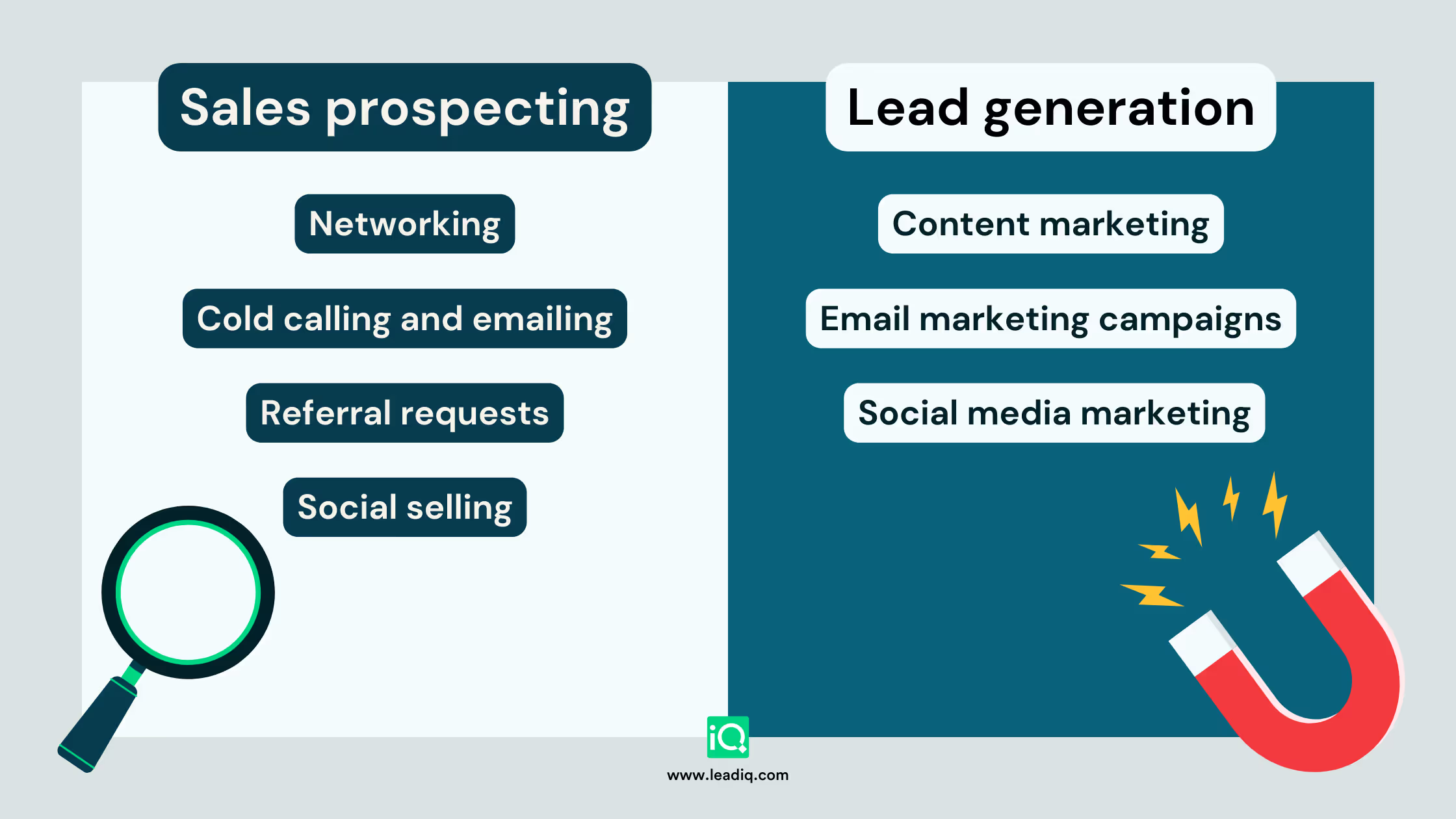Ready to create more pipeline?
Get a demo and discover why thousands of SDR and Sales teams trust LeadIQ to help them build pipeline confidently.

.avif)

Sales prospecting focuses on identifying and engaging specific potential customers, while lead generation casts a wider net to attract interest broadly.

For maximum effectiveness, sales and marketing teams should align their efforts, using shared goals, regular communication, and integrated tools to transition leads smoothly from generation to personalized engagement.

Combining both sales prospecting and lead generation creates a robust, well-rounded approach that enhances conversion rates and supports business growth.
Get a demo and discover why thousands of SDR and Sales teams trust LeadIQ to help them build pipeline confidently.
As a sales professional, unraveling the complexities of sales prospecting and lead generation is a vital part of your journey. It's about not only knowing their differences but also appreciating how they complement each other. These strategies form the heartbeat of profitable sales and marketing efforts. Yet, the line between them often blurs. For Sales Development Representatives (SDRs) and Account Executives (AEs), mastering these nuances is crucial. It enhances coherence in marketing teams, streamlines workflows, and boosts conversion rates. This article will distinguish the two, explaining their distinct roles and how they’re connected.
Sales prospecting and lead generation are both essential to customer acquisition, but they differ in approach and execution.
SDRs use sales prospecting to identify and engage potential clients, often those who haven't yet expressed interest in the product or service. It's about sparking one-on-one conversations, nurturing budding connections, and ultimately, guiding prospects to become valued clients.
In contrast, lead generation casts a wider net. It’s a strategy driven by marketing, focusing on drawing in a large pool of potential buyers. Marketing teams use tools like content marketing, SEO, and social media campaigns to pique their target markets’ interest and gather contact details for further engagement.
While both aim to cultivate conversions and inspire prolonged engagement, their roles in this process are distinct. Prospecting zeroes in on a targeted, personalized technique, often building upon the broad base established by lead generation. Understanding these strategies isn't just about spotting their differences. It's about valuing their unique contributions to the sales and marketing ecosystem.
Sales prospecting is the process of seeking and engaging with potential customers who fit your ideal customer profile (ICP), or the perfect customer for your product. Prospecting is strategic and should be personalized, as it lays the foundation for the rest of the sales pipeline. Typically, this task falls under the purview of Sales Development Representatives (SDRs) or Account Executives (AEs), who employ various tactics to uncover and connect with potential leads. Key activities in sales prospecting include:
For marketing teams, lead generation is an essential component of their outreach procedures. In fact, nearly 4 out of 5 marketers worldwide consider generating quality leads their top goal. It's not just about attracting a high volume of leads; it’s about qualifying and nurturing these leads to prepare them for eventual sales engagement. The synergy between lead generation and sales prospecting creates a robust and effective sales funnel.

Lead generation is a marketing activity that involves stimulating and capturing interest in a product or service. The aim is to attract potential customers (leads) and convert their curiosity into a vested interest in the company's offerings. This serves as a critical bridge between marketing efforts and tangible sales. Examples of lead generation activities include:
For marketing teams, lead generation is an essential component of their outreach procedures. In fact, nearly 4 out of 5 marketers worldwide consider generating quality leads their top goal. It's not just about attracting a high volume of leads; it’s about qualifying and nurturing these leads to prepare them for eventual sales engagement. The synergy between lead generation and sales prospecting creates a robust and effective sales funnel.

Choosing between a focus on sales prospecting or lead generation depends on your company's unique goals and market position. If your company offers a high-value, niche product, sales prospecting might be your golden ticket. This method allows for direct engagement and a personalized touch, critical for reaching a select group of potential clients.
If your aim is broad market reach, lead generation could be your path to success. It's particularly reliable for businesses launching new products or operating in competitive markets. Companies looking to rapidly expand their market presence, especially those consumer-focused, can greatly benefit from lead generation strategies like content marketing and SEO.
While you might lean more towards one or the other, remember that a balanced approach can often yield better results. Employing both sales prospecting and lead generation ensures a well-rounded engagement with the market.
Despite their differences, sales prospecting and lead generation yield the best results when aligned under a unified blueprint. Collaboration between sales and marketing teams is a pivotal step in both processes. Marketing teams can generate a pool of leads through various strategies, while sales teams can then take these leads and engage them on a more personal level. This synchronicity ensures a seamless transition from attracting interest to actively pursuing potential customers. Ways to collaborate include:
As companies find the right balance between prospecting and lead generation, they can also explore tools and technologies to make these methods more efficient and impactful. Having the right tool for the job makes the process more efficient and cost-effective.
Sales prospecting and lead generation are two fundamental components of the sales and marketing processes, each with its unique focus and methodology. While lead generation broadly captures potential interest, sales prospecting involves direct engagement with these potential customers. Although successful sales prospecting is the focal point for SDRs and AEs, collaborating with marketing teams to make the most of their lead generation efforts can lead to success for both teams—and the company’s bottom line.
The right prospecting platform is key to taking qualified leads to the next level. LeadIQ emerges as a powerful solution to streamline and enhance your sales prospecting efforts. With LeadIQ, you have access to accurate, verified contact data, simplifying the initial step of every sales prospecting effort. Our platform enables SDRs and AEs to seamlessly integrate this data into their CRMs with just one click. Stay ahead with automatic data enrichment, timely notifications on sales triggers, and leverage our advanced AI technology with Scribe to craft the perfect personalized messages. LeadIQ offers a comprehensive, efficient sales prospecting experience in a single, user-friendly tool.
To learn more about how to implement efficient prospecting strategies, download our ebook, "The Modern Prospecting Workflow."